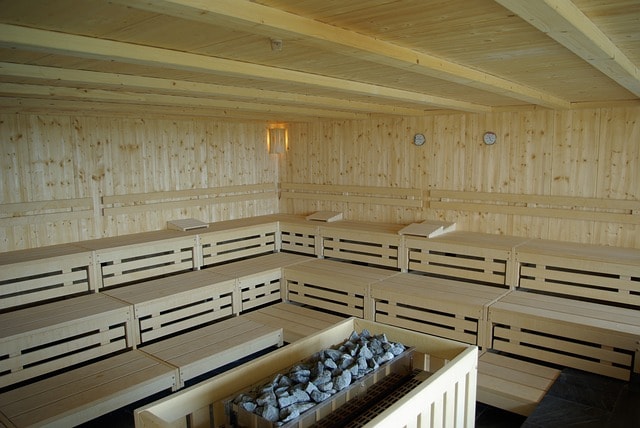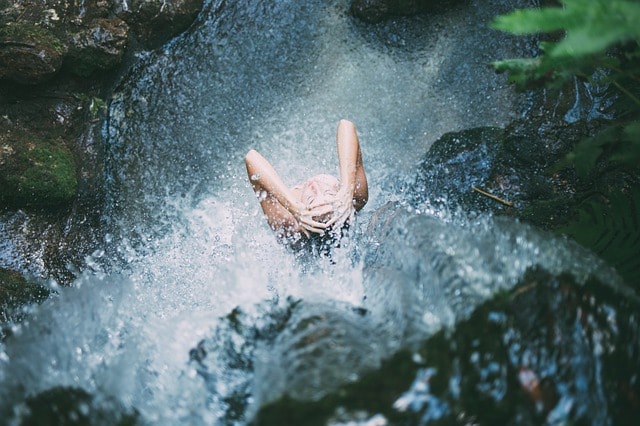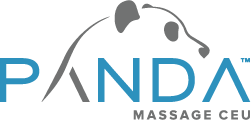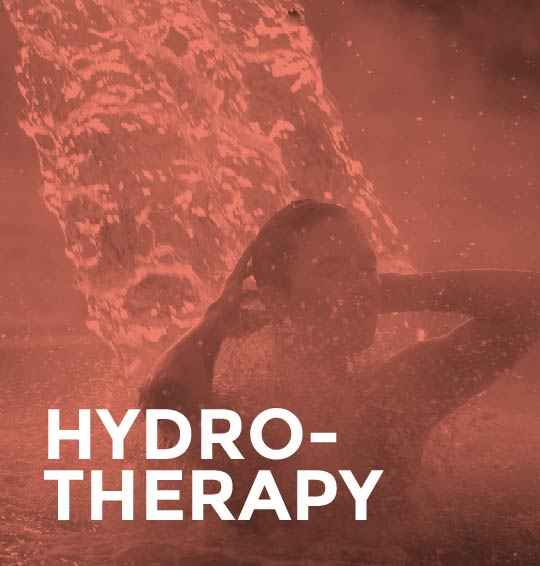Hydrotherapy Massage CEU Course – Outline and Learning Outcomes
As a professional massage therapist and bodyworker, there are dozens of techniques and modalities to choose from when treating your clients. When a new client comes to you, they expect that you’ll assess their condition, perform an intake, and then use their feedback to craft your approach to their therapeutic experience.
Swedish massage can relax your clients, melting their stress away. Hot stone techniques and deep tissue massage penetrate deep into your client’s musculature and fascial tissue, providing them with relief for stubborn, chronic conditions.
Sometimes, though, a more unorthodox approach is called for when treating a client. Perhaps they have an unusual combination of conditions, or an issue that’s not responding to traditional therapeutic methods.
Hydrotherapy can provide clients with pain relief, accelerate healing, and give you the results that you’re looking for as a massage practitioner. Are you ready to take the plunge into hydrotherapy? There are a lot of hydrotherapy courses out there. None of them are as extensive and professionally put together as ours. If you’re looking to get started with hydrotherapy, our massage CEU course will show you how. Let us be your guide as you develop a broad range of hydrotherapy techniques.
Learning Objectives for Our Hydrotherapy Massage CEU Course

Are you ready to begin your learning journey with our hydrotherapy program? Perhaps you’re still wondering if this is the right class for you. How can you know what to expect from the course? Will you really get anything out of it? Is it a good use of your time as a busy massage professional? No need to worry. Below, you’ll find an in-depth discussion of the course’s learning objectives, so you can be clear well in advance about what you can expect to gain from completing this class.
By providing you with an overview of this class, we’re not just helping you understand what you can look forward to learning. Additionally, we’re giving you the information you need for peak performance as an adult learner. While it may have been years since you’ve been in school, your desire and drive to learn as an adult are significantly greater than the average college age student. With an understanding of what you can expect from this course, you’ll be able to prime your brain for the information that we’ll be covering. This will help you focus your mental energy when approaching the coursework, and ensure that you experience maximum retention and comprehension.
Broadly speaking, our online program will discuss: the art of hydrotherapy; the use of various kinds of hydro packs; cold and hot applications; the physiological effects of hot and cold; the use of moist heat; how temperature affects reflexes; checking pulse and blood pressure; various applications; and the implementation of hydrotherapy techniques.
In particular, after finishing our course, you’ll feel confident in being able to:
Explain the Art of Hydrotherapy
Whenever you undertake the practice and application of a new therapeutic technique, one of the most essential things you have to consider is what any given client’s impression might be when you utilize it in a session. Will they be skeptical? Will they understand how and what you’re doing? In this course, you’ll learn how to expertly articulate the art of hydrotherapy, which will come in handy when working with clients.
Understand the Significance of Different Hydrotherapy Packs
With any treatment modality, there are certain tools of the trade. These allow you to make good use of this technique to provide your patients with the relief they need. When it comes to hydrotherapy, one of these important tools is the hydro pack. As part of this class, you’ll learn about the different kinds of hydro packs available to you as a practitioner, how to use them, and what effects they can have on your clients.
Define Cold Applications and Hot Applications
When people think of hydrotherapy, they often imagine the use of moist heat. However, both cold and hot applications are important in providing balanced treatment options to client. In this course, we’ll discuss the use of both hot and cold hydrotherapeutic applications.
Appreciate the Physiological Effects of Hot and Cold
In learning more about the application of heat and cold in therapeutic sessions, it’s necessary to thoroughly examine the physiological effects of both. As part of this class, you’ll learn about how cold and heat impact the body, and how to harness their physiological effects to provide your clients with pain relief, faster healing, and more.
Recall Various Types of Moist Heat
In the world of hydrotherapy, moist heat is one of the most powerful techniques in your toolkit. However, moist heat is a more complex topic that many people might at first suppose. In this course, we’ll discuss the various types of moist heat. You’ll learn about each of them in detail, and understand how to use them with patients.
Understand the Reflex Effects of Hot and Cold on the Body
Sometimes, as a massage therapist, we want to elicit a certain response from a client’s body in order to provide them with pain relief, help them heal, and so on. However, that’s often easier said than done. Fortunately, hydrotherapy provides an excellent opportunity to do just that. In this program, we’ll cover the so-called reflex effects of both hot and cold on the human form, and how to harness these effects to help your clients.
Demonstrate the Checking of Both Pulse and Blood Pressure
Hydrotherapy can have dramatic effects on the human body. On the one hand, this is encouraging: it means that a practitioner can create significant change in a client’s condition. At the same time, though, this implies that practitioners need to be cautious when treating clients. As part of this course, you’ll learn how to check pulse and take a client’s blood pressure. In doing so, you can track their physiological response over time.
Define Different Types of Spas
When most of us think of a spa, a single image pops into our head. In fact, though, there are a variety of different types of therapeutic spas, each with its own particular purpose and niche. In this class, we’ll define the different types of spas.
Understand the Four Different Methods of Transferring Heat
Depending on a client’s needs, there are a number of ways to make use of moist heat in a therapeutic setting. As part of this course, you’ll learn about the four different methods of transferring heat when treating clients. By understanding these different methods, you’ll have a range of options available to you when working with clients.
Explain Various Applications of Hydrotherapy
As with any other massage technique or modality, hydrotherapy has a number of applications for which it’s most ideally suited. Understanding which applications are most appropriate for hydrotherapy techniques will allow you to make use of your new knowledge in the most effective way possible. In this course, we’ll provide you with an in-depth understanding of hydrotherapy’s various applications.
Appreciate and Articulate the History of Hydrotherapy
One of the most exciting components of familiarizing yourself with any new treatment modality isn’t directly related to its application. Rather, it’s the accumulation of knowledge surrounding the history of the technique itself. Learning about the history of a modality like hydrotherapy is fascinating. In this class, we’ll teach you to appreciate and articulate this history.
Course Outline

As of now, you have an awareness of what you can expect to gain from taking this hydrotherapy courses. At the same time, however, you may be wondering: what exactly is covered in each section of this course? How much detail do the instructors go into? How is the program laid out? Is this class as thorough as other hydrotherapy classes?
We understand how important it is to feel confident about a course’s content before you commit time, energy, and money to pursuing it. That’s why we’ve provided you with an extensive, comprehensive outline of the entire class below. By familiarizing yourself with this outline, you’ll gain an appreciation for what the course covers in detail. Once you’re familiar with the contents, you can take note of which areas are less familiar to you, or which ones might present the greatest challenge based on your prior knowledge. This will allow you to better prepare yourself for the program, which will lead to a better learning outcome.
What is Hydrotherapy?
What is hydrotherapy? How is it defined? Can it be summed up in just a few sentences for the sake of curious clients? In this course, you’ll learn what hydrotherapy is, how it’s used, and how to articulate this information to current and prospective clients.
Benefits of Hydrotherapy
Hydrotherapy brings with it a whole host of benefits. As with any other treatment modality, many of these benefits are shared by other massage and bodywork techniques. At the same time, however, some of them are unique to the application of hydrotherapy. As part of this course, you’ll learn about these specific benefits in detail.
A Brief History of Hydrotherapy
Hydrotherapy has been in use across cultures for many centuries. In this course, we’ll discuss the history of hydrotherapy, touching on some of its most important figures and contributors, including: Hippocrates; Thomas Sydenham; James Jackson; Father Sebastian Kneipp; Benedict Lust; and Dr. John Harvey Kellogg.
Hydrotherapy in Healthcare and Spas
How is hydrotherapy utilized in a healthcare setting? What about when it comes to spas, which provide a different treatment setting entirely? In this part of the course, we’ll discuss the role of hydrotherapy in both of these treatment environments.
Types of Application
Hydrotherapy can be applied in a large variety of ways. Each of these application methods has its place as part of a practitioner’s skill set. In this course, we’ll discuss a range of hydrotherapeutic applications in detail, including: baths; sprays; tonic friction; and special water treatments such as packs, compresses, and medicated baths.
Hydrostatic Pressure
What is the science behind some of the effects of hydrotherapy? In this part of the course, we’ll delve into hydrostatic pressure, which is largely responsible for water’s effect on conditions like edema.
Water’s Properties and Physiological Effects
Like any other technique, hydrotherapy brings with it certain physiological effects. As it turns out, many of these effects are a result of the specific properties and physiological effects of water itself. In this course, we’ll discuss these properties and effects, along with the impact they’ll have on your clients.
Thermal Effects of Water
How does the temperature of water affect the body? In this section, we’ll discuss the thermal effects of water on your clients.
Water and Homeostasis
Homeostasis refers to your body’s ability to regulate and control itself. In other words, it’s your body’s capacity to stay in balance. Hydrotherapy can aid your body in this process. In this course, you’ll learn how it’s able to accomplish this.
Heat and the Treatment of Chronic Conditions
Chronic conditions can be some of the most challenging for massage therapists to work with. However, seeing a client improve after suffering from a chronic condition for years is also one of the most rewarding aspects of the profession. In this course, we’ll discuss how heat in the form of hydrotherapy can help clients with longstanding, chronic conditions.
Cold Therapy and Physiological Responses
Generally speaking, clients seeking out massage therapy are looking to having a relaxing experience. It might seem counterintuitive, then, to expose patients to cold therapy in a massage setting. In reality, though, cold therapy used in the right way can have positive physiological effects on the body. In this course, we’ll discuss how to utilize cold therapy and the effects it can produce.
Taking the Pulse and Checking Blood Pressure
As with any treatment modality, monitoring your client’s vital signs is important. In hydrotherapy, where temperature extremes can produce fluctuations in heart rate and blood pressure, checking vitals is essential. In this course, we’ll discuss how to take your client’s pulse and blood pressure to monitor their progress in a session.
Effects of Thermotherapy and Cryotherapy on the Nervous System
In addition to the myriad effects of hot and cold therapy on the physical body, thermotherapy and cryotherapy can also have a dramatic impact on the nervous system. As part of this program, you’ll learn about these effects and how they can benefit your clients.
Cold and Hot Packs
Cold and hot packs are an excellent way to make use of hydrotherapeutic techniques in an efficient and effective way as part of your massage practice. In this course, we’ll discuss the usage of both hot and cold packs.
Contraindications
As with any treatment modality, there are certain scenarios and conditions for which hydrotherapy is contraindicated. As part of this class, you’ll learn about these in detail. This will allow you to only utilize hydrotherapy in the most appropriate situations as part of your massage practice.
Application Methods for Hydrotherapy
With all of this information in hand, what’s the next step? To wrap up this course, we’ll provide you with an overview all of the various application methods of hydrotherapy. These include: hot packs; gel packs; thermal mittens and booties; hot and cold stone applications; body wraps; facial scrubs; steam wraps; oils; contrast packs; whirlpool baths; plunge baths; saunas; steam baths; and more.
What are CEUs, and Why are They Important?
Keeping up with your education is important as a massage therapist and bodyworker. However, your continuing education should be comprised of multiple parts. First, your day-to-day experience as a clinician will provide you with the practical education that you need. At the same time, it’s essential to seek out continuing education in a didactic setting. If you’re wondering how to pursue further education while maintaining the schedule of a busy massage therapist, look no further. Massage CEUs, or Continuing Education Units (GUIDE TO LMT CONTINUING EDUCATION), are an ideal means of continuing your massage education.
Remember: massage CEUs aren’t just important for your professional growth. Frequently, they’re actually required by law. Indeed, most states require that license therapists receive a certain number of CEU hours (NCBTMB GUIDE) per year (or sometimes over the course of two to three years) in order to continue holding a massage license.
Panda Massage CEU™ is proud to be an NCBTMB Approved Provider of CEUs. Our CEU courses fulfill national NCBTMB requirements. In addition, they count towards your annual CEU needs at the state level, enabling you to maintain your licensure.
Why Choose Panda Massage CEU?
There are other massage CEU classes available online, but many of them are of questionable quality. What makes Panda Massage CEU the right choice for your continuing education needs?
Quality
There are plenty of low quality online classes out there. Panda Massage CEU is different. We’re happy to offer the best online courses available anywhere.
Unique Topics
Most online courses cover the same handful of redundant topics. We offer a variety of exciting options like hot stones, deep tissue, kinesiology, and more.
Professional Narration
If you’ve ever taken an online course that was poorly narrated, you know what a challenge it can be to follow along. Our classes are professionally narrated, making it easy to keep up and retain the information being presented.
Video Included
Believe it or not, a lot of online courses out there don’t include any video material. All of our programs include videos, which helps to simulate the experience of an in-person course.
Self-Paced
We get it: you’re busy, and it’s daunting to think of how you’ll find the time to take an online course. That’s why all of our classes are self-paced. No matter what your schedule looks like, you can fit our courses into your day-to-day life.
Great Prices
Everyone agrees that quality is important. But what about price? At Panda Massage CEU, we’re proud to offer all of our courses at affordable prices that can fit any budget. And don’t forget: you’ll save thousands of dollars that you’d otherwise spend on travel for an in-person course.


There are no reviews yet.